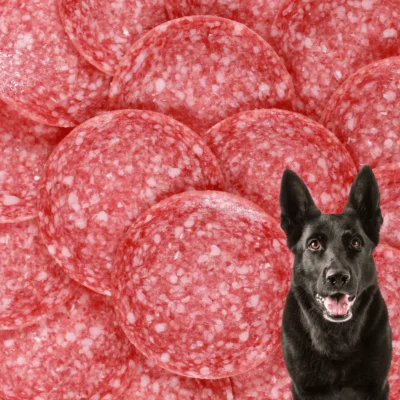Puppies, with their boundless energy and teething tendencies, deserve treats that are not only enjoyable but safe too. Enter Bully Sticks, a potential chewy delight for our little canine companions. The big question on puppy parents’ minds is whether these treats are safe for their furballs.
In this article, we’ll delve into the world of Bully Sticks to understand if they are a suitable and beneficial treat for puppies. From teething relief to dental health perks, let’s uncover the potential benefits and ensure our playful pups can safely indulge in these popular chew treats.
Here are the topics we’re going to discuss in this blog post:
- What are Bully Sticks?
- Can Puppies Have Bully Sticks?
- Health Benefits of Bully Sticks for Puppies
- What Size Bully Stick is Best for Your Puppy?
- Keep an Eye on Your Puppy’s Calorie Intake
- How to Safely Treat Your Puppy with Bully Sticks
What are Bully Sticks?

Bully sticks are a yummy treat made from a single ingredient—high-protein beef muscle, to be specific—sourced from a bull’s private part. These treats are dried and become hard, providing dogs with a long-lasting and satisfying chewing experience.
Bully sticks are known for being high in protein and low in fat, making them a nutritious option for dogs. They are often promoted as a dental health aid, helping to reduce plaque and tartar buildup as dogs chew on them. Pet owners need to monitor their dogs while they enjoy bully sticks to ensure safe chewing and to choose the appropriate size based on the dog’s breed and size.
Can Puppies Have Bully Sticks?
Yes, puppies can generally have bully sticks. Bully sticks are often considered a safe and natural chewing treat for puppies. They can be a helpful option during the teething phase, providing relief for sore gums and helping to keep the puppy entertained.
When giving bully sticks to puppies, it’s crucial to consider the size and thickness of the bully stick, as well as the puppy’s breed and size. Choose an appropriate size to avoid choking hazards, and supervise your puppy while they are chewing to ensure safe consumption.
Additionally, it’s a good idea to introduce new treats gradually and monitor your puppy’s reaction to ensure they tolerate the bully stick well. If you have any concerns or if your puppy has specific health conditions, it’s advisable to consult with your veterinarian before introducing bully sticks into their diet.
Health Benefits of Bully Sticks for Puppies:

Bully sticks can offer several health perils for puppies:
1. Dental Health:
The act of chewing on bully sticks promotes mechanical scraping and cleaning of a dog’s teeth. This helps to reduce the buildup of plaque and tartar, which can contribute to gum disease and other dental issues.
Chewing on bully sticks provides a natural gum massage. This action stimulates blood flow to the gums, which can contribute to healthier and stronger gums. By reducing plaque and tartar buildup, bully sticks can contribute to fresher breath in dogs. Improved oral hygiene often results in a more pleasant breath odor.
2. Teething Relief:
The natural chewing instinct in puppies intensifies during the teething phase. Bully sticks offer a satisfying and safe outlet for this behavior, helping to soothe their sore gums. The act of chewing provides comfort and relief as the puppy navigates the discomfort of growing new teeth.
Bully sticks are a natural and non-toxic option for teething relief. Unlike some synthetic teething toys or treats, bully sticks do not contain harmful chemicals and are less likely to cause adverse reactions.
3. Mental Stimulation:
Dogs, especially puppies, can get bored easily. Boredom can lead to destructive behaviors as a way for dogs to release pent-up energy. Bully sticks offer a productive and entertaining outlet for their energy, helping to reduce boredom and associated destructive tendencies.
Dogs may experience stress or anxiety, especially in new environments or during changes in routine. Chewing on a bully stick can act as a stress reliever, providing a calming and comforting activity that distracts them from potential stressors.
4. Rich in Protein:
Protein is essential for building and repairing tissues, making it crucial for muscle development. The protein found in bully sticks contributes to the overall health and strength of a dog’s muscles.
Proteins are composed of amino acids, which are essential for various bodily functions. Bully sticks offer a well-rounded amino acid profile, supporting optimal health and well-being in dogs.
5. Low in Fat:
The lower fat content in bully sticks makes them suitable for dogs that require weight management. Dogs with specific dietary restrictions or those prone to weight gain can enjoy a tasty treat without an excessive intake of fat.
A diet moderately high in fat is often recommended for maintaining cardiovascular health in dogs. By providing a treat like bully sticks with low-fat content, pet owners can contribute to their dog’s heart health as part of an overall balanced diet.
6. Digestible Goodness:
Bully sticks are made from a single ingredient: the pizzle of bulls. This natural composition makes them easier for dogs to digest compared to treats with complex or artificial ingredients.
The simplicity of bully sticks makes them a suitable option for dogs with sensitive stomachs. Their digestible nature reduces the risk of digestive upset, making them a reliable and well-tolerated treat for many dogs.
7. Long-Lasting Enjoyment:
The natural composition and drying process of bully sticks results in a texture that dogs find satisfying to chew. This chewy texture promotes extended chewing sessions, offering dogs prolonged enjoyment compared to some softer treats.
Bully sticks are an excellent choice for dogs left alone for short periods. Their durability ensures that dogs have a satisfying and engaging activity to focus on, reducing the likelihood of boredom-related behaviors.
What Size Bully Stick is Best for Your Puppy?
Bully sticks make an excellent choice for puppies due to their long-lasting nature. These sticks endure longer than regular dog chews because they are baked at high temperatures after being hung to dry, resulting in a satisfying hardness. Additionally, they offer versatility as they come in various sizes, allowing you to adapt to your pup’s changing needs as they grow into adulthood.
You’ll find bully sticks in lengths of 6 inches or 12 inches, with thickness variations ranging from slender 10 millimeters (mm) to extra-thick sizes of 23 mm or more.
It’s crucial to select sticks that align with your dog’s weight. If a stick is too large, it might be too much for your puppy to handle in one go, potentially causing mild stomach distress. On the other hand, offering a stick that’s too small may reduce the time your puppy spends engaged with it, minimizing its benefits and increasing the risk of choking or intestinal obstruction if swallowed without proper chewing.
For a practical approach, consider this sizing chart based on your puppy’s weight. Start with smaller and thinner sticks initially, gradually introducing 12-inch sticks once your dog reaches at least 45 pounds.
| Dog Weight | 6” Thin | 6” Reg | 6” Thick | 12” Reg | 12” Thick | 12” Extra Thick |
| < 15 Ibs | ✓ | |||||
| 15-30 Ibs | ✓ | |||||
| 30-45 Ibs | ✓ | ✓ | ||||
| 45-60 Ibs | ✓ | ✓ | ✓ | ✓ | ||
| 60-75 Ibs | ✓ | ✓ | ✓ | ✓ | ||
| 75-90 Ibs | ✓ | ✓ |
When choosing the right bully stick for your puppy, it’s essential to factor in their chew strength and preferences. For those with a power chewer, opting for a size up in bully sticks is a smart move.
Keep an Eye on Your Puppy’s Calorie Intake:
Monitoring your puppy’s calorie intake is crucial for maintaining a healthy weight. Bully sticks, being dense chews, are high in calories. It’s essential to adjust any additional treats given on days your dog enjoys bully sticks to account for the extra calories while keeping their regular food intact to ensure a balanced diet.
As a general guideline, a 6-inch medium bully stick averages about nine calories per inch, totaling approximately 54 calories per stick. We recommend offering bully sticks no more than two to three times a week unless you remove the stick before it’s completely consumed. Making a bully stick last through multiple chew sessions is a great way to manage their calorie intake while still providing an enjoyable treat.
How to Safely Treat Your Puppy with Bully Sticks:

Safely treating your puppy with bully sticks involves a thoughtful approach to ensure both enjoyment and well-being. Begin by selecting the right size of bully sticks suitable for your puppy’s breed and size to prevent choking hazards. During chewing sessions, always supervise your puppy, intervening if necessary, and setting reasonable time limits to avoid overindulgence.
Regularly inspect the bully stick for signs of wear, replacing it if it becomes small enough to swallow or develops sharp edges that could harm your puppy’s mouth. Provide fresh water during chewing to keep your puppy hydrated and wash away any residue. Monitor their digestive health, noting any changes in stool consistency or behavior.
Introduce bully sticks gradually, especially for first-timers, and observe your puppy’s reactions. Before making bully sticks a regular treat, consult with your veterinarian, particularly if your puppy has existing health conditions, to ensure a safe and enjoyable chewing experience.
Final Thought:
In conclusion, introducing your puppy to the joy of Bully Sticks can be a rewarding experience, offering not only a delicious treat but also numerous health benefits. From aiding in dental health and providing teething relief to offering mental stimulation and being rich in protein, these chew treats cater to various aspects of your puppy’s well-being.
Ensuring the safety of your puppy during Bully Stick enjoyment involves thoughtful considerations, such as selecting the right size, supervising chewing sessions, and monitoring their digestive health. The versatility in sizes makes Bully Sticks suitable for puppies of different breeds and sizes, providing long-lasting enjoyment that keeps them engaged and content.
Remember to keep an eye on your puppy’s calorie intake, especially considering the calorie density of Bully Sticks. Moderation is key to maintaining a balanced diet while still offering a delightful treat. Regularly consult with your veterinarian to address any specific concerns related to your puppy’s health and dietary needs.
In the end, with proper care and attention, Bully Sticks can become a cherished addition to your puppy’s treat repertoire, contributing not only to their happiness but also to their overall health and well-being.
FAQs:
1: What part of the bull is the bully stick?
Bully sticks are crafted from a rather unconventional source: bull penises. Yes, it might not be the most suitable topic for dinner discussions with your grandma, but the reality is that these chewy treats are composed of 100% beef “pizzle,” a whimsical term for the muscle found in a bull’s penis.
2: At what age can a puppy have a bully stick?
Yes, bully sticks are safe for puppies over five pounds with all their adult teeth, usually around six months old. These natural chews consist of a single ingredient: beef pizzle.
3: Are bully sticks safe for teething puppies?
Yes, bully sticks are great teething toys for puppies. They are soft on delicate gums but provide satisfying chewing. Consider transitioning to a larger size as your puppy’s teeth grow stronger.
4: Can a 3-month-old puppy chew on a bully stick?
Dogs of any breed, age, or size can safely enjoy bully sticks. They are safe for puppies as long as they can chew hard food independently. Bully sticks offer high protein and dental health benefits for both puppies and adult dogs alike.
5: Are bully sticks salty?
Bully sticks made through traditional methods typically contain no added flavorings and are seasoned with the naturally occurring salt found in the pizzle itself.












